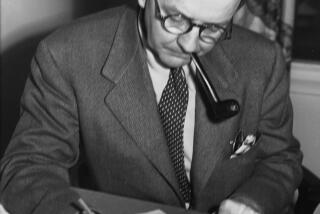Bardâs Sonnets : A Mystery at Long Last Resolved?
One of the longest-running debates in literary history has been over the identity of a mysterious âMr. W. H.â to whom Shakespeareâs sonnets were dedicated in 1609.
Over the years, literally hundreds of books, articles and theses have been written by scholars speculating on who âW. H.â was and what his relationship may have been to the Great Bard.
Was he the man who procured the manuscript for Thomas Thorpe, a London stationer who was the publisher of the 1609 quarto edition? A friend who inspired Shakespeare to write the sonnets in the first place? Was he, as some have speculated, Shakespeareâs male lover?
Another Theory
Renaissance scholars have never been able to agree. And now, writing in the current issue of the Publication of the Modern Language Assn., the journal of the countryâs largest literary society, a young Vassar College professor has posed yet another theory: âW. H.â never existed; the initials were incorrectly printed, and should have been those of William Shakespeare himself.
It âappears virtually certain,â writes Donald Foster, assistant professor of English at Vassar, âthat âW. H.â is simply a misprint--perhaps the most well-honored typographical error in the history of world literature.â
Fosterâs theory is based on analyses of hundreds of manuscripts of the period and a study of the British printing industry in the 17th Century.
If the theory withstands an expected onslaught of literary rebuttals, the âW. H.â matter will be added to a list of maddening and sometimes amusing typographical errors that have vexed scholars for years.
Classic Case
The classic case of a typographical error that has mistakenly engendered much critical attention, even from the likes of such great literary scholars as F. O. Matthiessen, is that of the âsoiled fishâ in Herman Melvilleâs âMoby Dick.â Matthiessen lavished much critical admiration on the âsoiled fishâ image only to have literary historians discover some years later that âsoiledâ was a printerâs error. What Melville actually wrote was âcoiled.â
In the âArt of Literary Research,â Richard D. Altick lists numerous other examples of literary typos. In the first American editions of Henry Jamesâ 1903 novel âThe Ambassadors,â Chapter 29 was printed before Chapter 28. âThe Scarlet Letterâ by Nathaniel Hawthorne was also full of mistakes. It was not until 1961 that the first-edition text of the 1850 novel, the only edition that Hawthorne himself corrected, became available to modern readers, Altick said.
David Daiches, a British literary critic and scholar, points out that âin the first one-volume American edition of the collected poems of W. B. Yeats there are at least half a dozen misprints that completely change the meaning of passages in which they occur, and in some cases critics have actually analyzed the misprinted poems unaware of the errors, and have justified and even praised the mistaken words.â
When James Joyce wrote âUlyssesâ in 1922, the Irish novelist said he intended to keep the universities busy well into the next century. So far, he is succeeding admirably, but not always in the way he intended. In fact, when scholars recently completed a seven-year task of revising âUlyssesâ to bring it as close as possible to what James wrote, they found more than 5,000 mistakes--at least 50 of which were considered significant enough to alter the meaning of the novel.
Fosterâs theory that âW. H.â is also a misprint has been suggested before, as have theories for almost every conceiveable topic in Shakespearean studies. But the general reaction among many scholars who have read Fosterâs article is that his arguments are more tightly reasoned and the evidence he presents more persuasive than those of earlier scholars who have written on the same subject.
Regardless of whether his theory is accepted, the method by which he arrived at it illustrates a recent and fundamental change in literary scholarship, said William Schaeffer, executive vice chancellor of UCLA and former executive director of the Modern Language Assn.
Cultural Context
After nearly three decades of scrutinizing literary texts through a microscope of abstract theories about the structure of language and the meaning and non-meaning of words, a growing number of literary scholars are returning to what might be considered an old-fashioned approach to literary criticism: That is, they are reading novels and poems in light of their broad historical and cultural contexts.
Schaeffer, who recently announced his intention to leave administration and return to full-time teaching and scholarship in UCLAâs English department, said it would overstate the case to describe the changes in literary criticism as a revolution.
But what is clear, he said, is that a few very bright and very interesting scholars are âmoving away from the âconstructionismâ and âpost-constructionismâ and the âdeconstructionismâ of the past few years which have become . . . so abstract as to be absolutely destructive to any sane reading of literature.â
While it was once routine for literary scholars to try to place works of literature into their historical contexts, beginning in the 1950s a group of so-called New Critics became concerned with the meaning of the texts themselves, devoid of such outside or âextraneousâ concerns as how the work compared to others of its time or what the author really intended.
Eventually critics and scholars became so preoccupied with textual analysis that they lost interest in the meaning of works of literature and became preoccupied simply with their structure. By the mid-1970s the structuralist movement had given way to a âdeconstructionistâ theory of literature, a philosophical approach based on the writings of a Frenchman named Jacques Derrida. In essence, the deconstructionist movement, which has largely been centered at Yale University, gave up all hope of finding any meaning in literature or even in words themselves.
Resurrection of Sorts
âThere was a period when everything seemed to be derived from the Yale School of Deconstruction,â said Joel Conarroe, a past president of the Modern Language Assn. and now president of the Guggenheim Foundation in New York. âSince then, others . . . perhaps the most noted of whom is Stephen J. Greenblatt at Berkeley . . . have brought about a kind of resurrection of a previously outmoded approach of putting literature into its context.â
But even within this branch of literary criticism, there are two distinct camps: literary critics who practice the so-called new historicism, and the old school of literary critics who have never given up on or are returning to more traditional, more conservative literary studies, explained Carol Crist, chair of Berkeleyâs English dpartment.
The new historicism, based on the work of French philosopher Michel Foucault, looks at literature as âa manifestation of cultural symbolismâ--meaning that literature is seen not just as an act of creation but one of many reflections of the culture out of which it arises. Hence, Crist said, a new historian might study sexism or power struggles in a particular period and then show how that sexism or those struggles were reflected in the literature of the time.
In contrast, the old historicism focuses first on the literature and then uses historical information--such as the state of the printing industry or the literary conventions of the period--where it might help explain the meaning of a piece of writing.
This latter approach is the one Foster used in his search for the identity of âMr. W. H.â
In a telephone interview from his home in Poughkeepsie, N.Y., Foster explained that he began his work on Shakespeareâs mystery man as a graduate student preparing for his oral examinations at the University of California, Santa Barbara.
Close Reading
When he read the dedication to the poems closely for the first time, Foster said, he âthought it oddâ that the âbegetterâ of the poems could be, as most scholars have hypothesized, someone other than the author himself. As Foster immersed himself in the writing of the period, scrutinizing original manuscripts of both famous and obscure writers, he found that the word âbegetterâ was in common use, but was invariably used to refer to the writer rather than to someone else.
Next, Foster took note of what would be obvious to anyone reading original manuscripts, as opposed to revised or corrected editions: The originals were full of typographical errors. âGenerally speaking,â Foster said, âRenaissance publications were badly proofread, if at all.â
In fact, even without making an exhaustive study, Foster was able to point to a dozen examples of nearly contemporaneous works in which the authorâs initials were inadvertently misprinted. This led the young Shakespearean scholar to conclude that âW. H.â might well be a misprint too.
In support of this theory, Foster noted that Thomas Thorpe, the publisher of the sonnets and the apparent author of the dedication, often signed his own initials âTH. TH.â or âT. Th.â and that Shakespeareâs name was similarly abbreviated in some documents of the period as âW. SH.â
What may have happened is that Thorpe wrote âMr. W. SH.â and the printer simply omitted a letter, âa mistake not likely to be noticed in a hasty proofreading.â Another possibility, Foster said, is that the printer simply miscast âW. S.â as âW. H.â
âI am not presumptuous enough to think that âMr. W. H.â will now rest in peace,â Foster said.
But with a certain satisfaction, Foster noted that he has received a considerable number of favorable letters and responses to his article. This suggests that his solution to this Shakespearean mystery has âcreated some considerable excitement,â he said, âso far as anything in literary studies causes excitement.â
More to Read
Sign up for our Book Club newsletter
Get the latest news, events and more from the Los Angeles Times Book Club, and help us get L.A. reading and talking.
You may occasionally receive promotional content from the Los Angeles Times.







